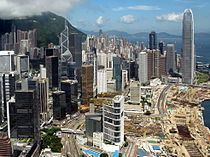Traditional Chinese 中環 Hanyu Pinyin IPA [tsʊ́ŋ wȁːn] University HKUST Business School | Simplified Chinese 中环 Yale Romanization Jūng Wàahn Jyutping Zung waan | |
 | ||
Restaurants SoHo, 蘭芳園Lan Fong Yuen, Lin Heung Tea House, Yat Lok Restaurant, Sevva, JW Marriott Hotel Ho Hotels Mandarin Oriental - Hong Kong, Mini Hotel Central, Conrad Hong Kong, JW Marriott Hotel Ho, Island Shangri‑L Hong Kong | ||
Central (also Central District; Chinese: 中環) is the central business district of Hong Kong. It is located in Central and Western District, on the north shore of Hong Kong Island, across Victoria Harbour from Tsim Sha Tsui, the southernmost point of Kowloon Peninsula. The area was the heart of Victoria City, although that name is rarely used today.
Contents
- Map of Central Hong Kong
- Naming
- Location
- History
- Economy
- Office buildings
- Streets and squares
- Government buildings
- Other historical buildings
- Hotels
- Entertainment areas
- Places of worship
- Parks
- Schools
- Former buildings
- Public transport
- Expressways and routes
- References
Map of Central, Hong Kong
As the central business district of Hong Kong, it is the area where many multinational financial services corporations have their headquarters. Consulates general and consulates of many countries are also located in this area, as is Government Hill, the site of the government headquarters. The area, with its proximity to Victoria Harbour, has served as the centre of trade and financial activities from the earliest days of the British colonial era in 1841, and continues to flourish and serve as the place of administration after the transfer of sovereignty to China in 1997.
Naming
The area of Chung Wan (中環), named Central in English, was one of the districts (四環九約) in Victoria City. The English name Central became prevalent after the Island Line of the MTR metro system was built in the early 1980s, and the connected stations of Pedder and Chater renamed as Central. On some older maps, it and the area to its west are named Kwan Tai Lo (羣帶路) below Victoria Peak. It formed a channel, Chung Mun (中門), with Tsim Sha Tsui, on the sea route along the coast of southern China. The eastern part of Central District has been known as Admiralty since the completion of Admiralty Station in the early 1980s.
Location
Central is located on the north shore of Hong Kong Island, across Victoria Harbour from Tsim Sha Tsui, the southernmost point of Kowloon Peninsula. It is bordered in the west by Sheung Wan, with the border being along Aberdeen Street (also called Wing Kut Street). It is bordered in the east by Admiralty, an eastern extension of the central business district. As such, Admiralty is sometimes considered a part of Central. Central is bordered in the south by Mid-levels, an area halfway up Victoria Peak. The boundary between Central and Mid-levels is not clearly defined.
For district council elections purposes, the area, together with Admiralty, correspond roughly to the "Chung Wan" constituency. The boundaries of such constituencies may be subject to modification.
History
The British landed on Possession Point of Sheung Wan in 1841. They soon decided to build a city on the north coast of Hong Kong Island, and the present-day Central was chosen to house major military facilities and an administrative centre. The area soon attracted both Westerners and Chinese to trade and live in the area, and a Canton Bazaar (precursor of Central Market) was built between Cochrane Street and Graham Street in 1842. The area was soon zoned for Westerners only, and the Chinese residents were restricted to Sheung Wan. [It was zoned for "Western-style buildings," meaning buildings with minimum space and hygiene standards]. The area was largely dominated by the presence of Victoria City. The popularity of this area would also boost the population of Hong Kong from 5,000 in 1841 to 24,000 in 1848. Government House and other Hong Kong Government buildings were completed during this period on Government Hill. Various barracks, naval base and residence of Commander, Flagstaff House were built on the east end of the district. Between 1860 and 1880 the construction of City Hall, Theatre Royal and other financial structures made Central the heart of Hong Kong.
In 1904 the Praya Reclamation Scheme added 59 acres (24 ha) of land to Central's waterfront. Many of the proposals came from Sir Paul Chater and James Johnstone Keswick. During the 1920s, Hong Kong was able to push far ahead economically, because of the cohesive collaboration between Central and all waterfront commerce.
The military structures survived until the 1980s. Only Flagstaff House remains as Museum of Tea Ware in Hong Kong Park. City Hall sat on the present premises of the HSBC Hong Kong headquarters. Hong Kong's first road, Queen's Road, passes through the area and the business centre continued to expand toward the shoreline as far as the reclaimed lands.
Economy
Bank of China (Hong Kong) has its head office in the Bank of China Tower. The Hongkong and Shanghai Banking Corporation, a subsidiary of HSBC, has its head office in the HSBC Main Building. Bank of East Asia and Hang Seng Bank have their head offices in Central.
Before 1999, Cathay Pacific had its head office in the Swire House in Central. In 1999 the airline relocated its head office to Hong Kong International Airport.
Nord Anglia Education, which operates international schools in various countries, has its head office in Central.
Office buildings
Streets and squares
Government buildings
Other historical buildings
Hotels
Central, together with Tsim Sha Tsui and Tsim Sha Tsui East, is home to many hotels.
Entertainment areas
Places of worship
Parks
Schools
Former buildings
Public transport
The area is a major transport hub for Hong Kong (see also Transport in Hong Kong).
